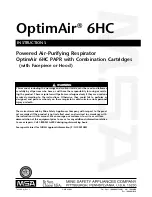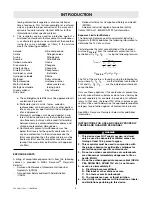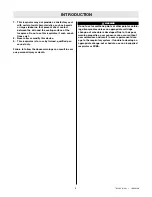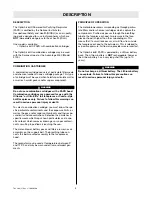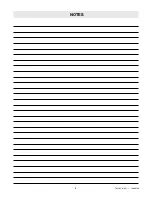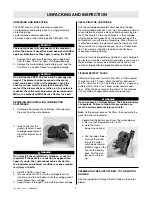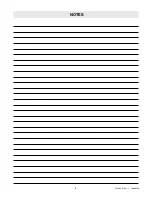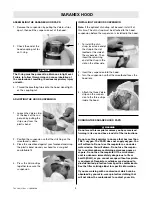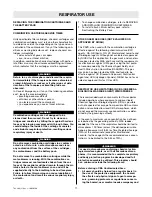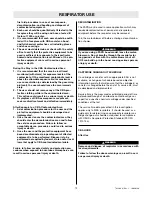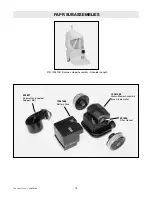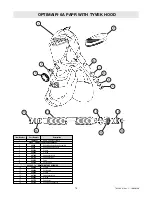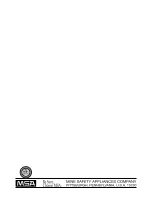
RESPIRATOR USE
REPLACING THE COMBINATION CARTRIDGES AND
THE BATTERY PACK
COMBINATION CARTRIDGE SERVICE TIMES
Unlike particulate filter cartridges, chemical cartridges and
combination cartridges must rely on other characteristics
to determine service life, depending on the type and con-
centration of the contaminant. If any of the following con-
ditions or warning indicators exist, replace chemical car-
tridges immediately:
• odor or taste of gases or vapors
• eye, nose, or throat irritation
In addition, combination chemical cartridges with particu-
late filters also may show increased breathing resistance,
which indicates that the cartridges must be replaced.
Return to a safe atmosphere and discard the respira-
tor immediately if the facepiece becomes discolored,
crazed, blistered or cracked, or if other signs of dete-
rioration of the facepiece or breathing tube are
observed.
In Case of Emergency, or if any of the following conditions
exist, leave the area immediately:
• breathing becomes difficult
• dizziness or other distress occurs
• you taste or smell the contaminant
• you experience eye, nose or throat irritation.
Combination cartridges are not designed to be
cleaned and then reused. Do not try to clean car-
tridges and canisters by hitting them against hard sur-
faces or by blowing compressed air through them. You
could damage the inside of the cartridge or canister
and eliminate respirator protection, resulting serious
respiratory injury or death.
Do not remove combination cartridges in a contami-
nated area. Return to a safe atmosphere and clean
any contaminant from the surface of the cartridges,
the motor-blower, and the battery pack.
Do not remove the combination cartridges while the
motor-blower is running. With the combination car-
tridges removed, contaminants shaken from the sur-
faces of the respirator will be drawn in through the air-
intake holes in the motor-blower case, and will be
supplied directly to the breathing tube and facepiece.
Failure to follow this warning can cause inhalation of
the contaminant and result in serious respiratory injury
or death.
1. To change combination cartridges, refer to REMOVING
AND INSTALLING COMBINATION CARTRIDGES.
2. To install a fresh Lithium battery pack, refer to
Reattaching the Battery Pack.
OTHER GAS MASK USES (NOT EVALUATED OR
APPROVED BY NIOSH)
This PAPR, when used with the combination cartridge is
effective against the following chemical warfare (CW)
agents, GA, GB (Sarin), GD, VX, Mustard and Lewisite and
all biological agents. Although not evaluated or approved
by NIOSH for this application, the gas mask and canisters
have been tested by MSA and have met the requirements
for effectiveness against CW agents using the test proto-
col recommended by the Chemical Agent Safety and
Health Policy Action Committee (CASHPAC). This gas
mask also has been tested by MSA and found to be
effective against OC (Oleoresin Capsicum) Riot Control
Agent and HCN (Hydrogen Cyanide). NIOSH has not eval-
uated or approved this for OC or HCN.
RESPIRATOR USE LIMITATIONS IN CBA (CHEMICAL-
BIOLOGICAL WARFARE AGENT) ATMOSPHERES
The recommended work environments for this respirator
include operations where exposure to vapor or liquid
Chemical Agents or Biological Agents (CBA) is possible
but not expected, for escape from possible CBA contami-
nation and controlled low level CBA atmospheres, which
do not exceed the maximum use concentration as deter-
mined by the governing authority.
In the event a maximum use concentration has not been
established by the governing authority, MSA
recom-
mends
that the use of the respirator should be limited to
atmospheres 100 times (or less) the defined permissible
Airborne Exposure Limit (AEL) or Time Weighted Average
(TWA) of the contaminate (except for Mustard and
Lewisite; for these agents the recommended use concen-
tration is to be limited to the AEL or TWA).
For uses in atmospheres containing chemical or bio-
logical warfare agents, as with all hazardous atmos-
pheres, it is recommended that a complete respiratory
and body protection program be developed and full
protective ensemble be utilized. This program should
as a minimum include the following items:
Before entering a CBA Contaminated Area
1. All users should be trained (on a regular basis) in
the use of the protective equipment, the hazard,
the effects and physical signs of agent overexpo-
sure, governing protocols or regulations concern-
ing the hazard, user medical needs emergency and
11
TAL 209 (L) Rev. 1 - 10040590
WARNING
WARNING
WARNING
WARNING
Содержание OptimAir 6HC
Страница 6: ...NOTES 6 TAL 209 L Rev 1 10040590 ...
Страница 8: ...NOTES 8 TAL 209 L Rev 1 10040590 ...
Страница 15: ...15 TAL 209 L Rev 1 10040590 20 ...
Страница 16: ......

